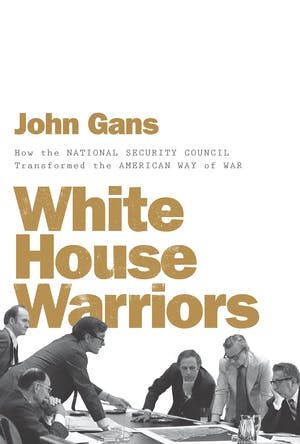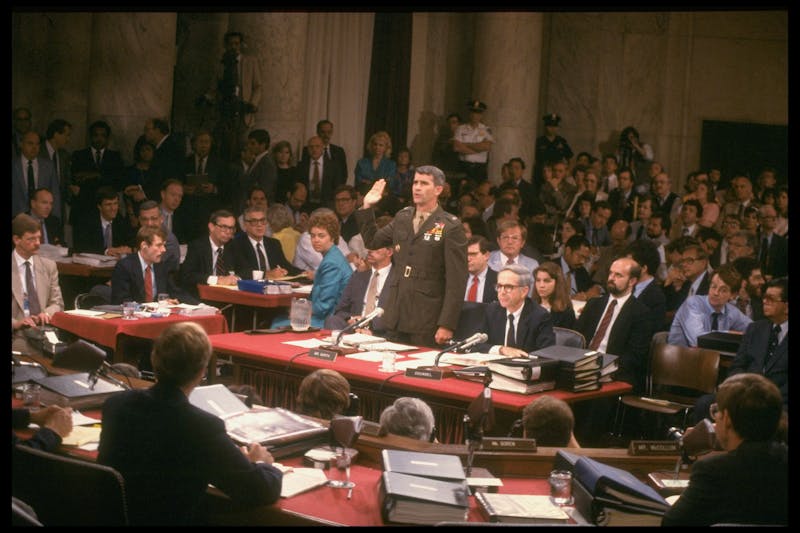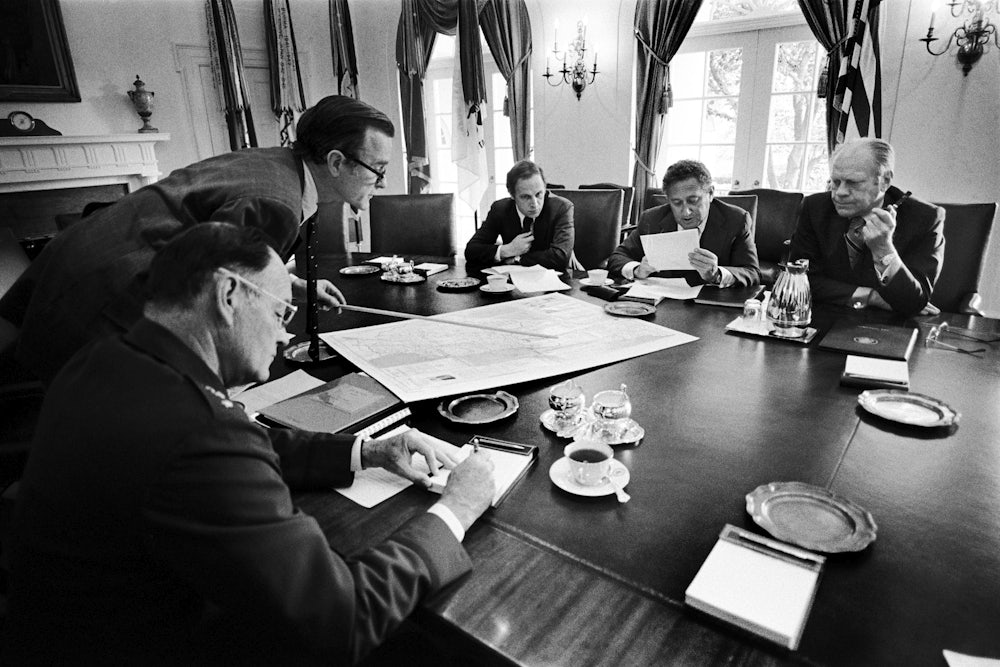In 1947, two years after the United States emerged victorious in World War II, the 80th U.S. Congress passed the National Security Act, which created the Department of Defense (originally titled the National Military Establishment), Central Intelligence Agency, and National Security Council. Though the nation had demobilized after the war, anxieties about communism quickly permeated the American foreign policy establishment. To combat the Soviet Union—and to manage the nation’s increasingly global interests—decision-makers established, for the first time in American history, a peacetime “national security state” able to deploy thousands of weapons and millions of troops all over the world.

Compared to its better-known counterparts, the National Security Council remains something of a mystery. Headquartered in the Eisenhower Executive Office Building, next to the White House and a block away from the Council on Foreign Relations, the NSC bridges the gap between the intellectuals and decision-makers of the foreign policy establishment. The council, in short, is a core institution of the “military-intellectual complex,” the network of organizations that since the late-1940s have provided government officials with the ideas they rely on to make foreign policy. If the military-industrial complex builds the weapons of American empire, the military-intellectual complex develops the concepts that determine where such weapons are actually used.
In his breezy White House Warriors, John Gans offers an enlightening summary of the NSC’s history from the Truman through the Obama Administrations. This is a story of some of the best-known—and most reckless—players in the history of U.S. foreign policy, including Henry Kissinger, Zbigniew Brzezinski and Oliver North; of wars plotted and planned behind closed doors; of power struggles between advisors and presidents; of many bad suggestions and very few good ones. Ultimately, it is a story that underlines the problems with centralizing power in a White House controlled by an unaccountable cohort of “the best and the brightest” whose records suggest they are anything but.
Gans is a man of the establishment—he worked at the Pentagon and Treasury Department and served as a speechwriter for Ash Carter, Chuck Hagel, and Jack Lew. Yet even he is anxious about the NSC’s unregulated power. Of all the institutions of U.S. foreign policymaking, the NSC is among the most undemocratic. Neither the National Security Advisor nor the NSC staff is confirmed by the Senate, and the group operates “with little legal foundation, oversight from Congress, or exposure to the press and the American public.” This is not how policymaking should be done in a democracy. Though Gans often admires the intellectuals that his book covers and makes the case for mild reform, the evidence he collects suggests the need for a much more thoroughgoing re-imagining not only of the NSC, but of the entire structure of U.S. foreign policymaking.
Gans begins his story in the late-1940s, with the founding of several new institutions—the NSC, CIA, DOD—designed to organize the nation’s vast resources. During World War II, President Franklin Delano Roosevelt had taken an ad hoc approach to administration, fostering a policymaking environment in which lines of authority were unclear. To ensure a more coherent policy process in the emergent Cold War, the foreign policy establishment demanded more structure, which the NSC was intended to provide.
But there was another, equally important, reason for the NSC’s creation: the widespread fear that the traditional institutions of American democracy—slow, ponderous, and often irresponsible—were too fickle to win a struggle with an unscrupulous “totalitarian” enemy like the Soviet Union. For this reason, after World War II elites seized the opportunity to form a “garrison state” in which, as the political scientist Harold Lasswell put it, authority was “dictatorial, governmentalized, centralized, integrated.” The NSC was a linchpin in this effort, and it is perhaps the defining institution of the “imperial presidency” that has done so much damage to America and the world.
Nevertheless, in the NSC’s first years of existence, President Harry Truman “mostly avoided” its meetings. It was only after the Korean War’s outbreak in June 1950 that the NSC began to emerge as a major player in U.S. foreign policymaking. The conflict, which militarized and globalized the Cold War, convinced the president that he needed to use the NSC to better harmonize his ever-more-complex foreign policy. Truman started to chair more NSC meetings; ensured the council met at least once a week; and, most importantly, “demanded that his decisions on Korea and other issues be channeled through—and coordinated by” the NSC. Truman thus initiated a trend toward centralization of foreign policymaking in the White House that would increasingly characterize American decision-making.
President John F. Kennedy further concentrated power around his person. At the recommendation of Richard Neustadt, a Columbia University political scientist who specialized in the American presidency, Kennedy made “NSC staffers not servants of the larger National Security Council but instead a ‘tight group of very able general utility assistants’ to the president himself.” Kennedy, in the words of one State Department official, essentially established a “foreign office in microcosm” headquartered in the White House. Unfortunately, it turned out that empowered NSCs staffers were not always particularly wise. To take just one example, it was an NSC staffer who convinced Kennedy to support the 1963 coup against Ngô Đình Diệm, the president of South Vietnam, which set the stage for deeper American involvement in the Vietnamese civil war.
The problems with emboldening the NSC became even clearer when Richard Nixon assumed the presidency in 1969. Nixon appointed Henry Kissinger, a respected Harvard political scientist, his National Security Advisor. With the aid of his colleague Mort Halperin, Kissinger reformed the NSC by giving it “the power to review and either approve or reject the bureaucracy’s ideas; and if the options were still bad,” he authorized the NSC staff to “develop new ones for the president.” As a result of this reorganization, “all ideas that did not come from the president went through Kissinger.” Kissinger thus placed himself at the center of the national security process, fashioning a personalist system that ensured he—with Nixon’s support—was in charge of foreign policy. This was a remarkable achievement for an individual who had never before served in government.
Despite the disastrous failures of Kissinger’s foreign policy—most notably, he and Nixon expanded the Vietnam War and achieved little in result—his NSC remained the model for future administrations. Even the liberal President Jimmy Carter “affirmed the NSC’s position in the system” by allowing his National Security Advisor, the Columbia political scientist Zbigniew Brzezinski, to design a personalist policy process that attenuated the influence of the State Department, Defense Department, and other elements of the security bureaucracy. Regardless of whether they were a Republican or a Democrat, Cold War presidents consistently centralized power in their White Houses.

President Ronald Reagan’s NSC again highlighted the dangers of such centralization. In his first term in office, NSC staffers persuaded Reagan to deploy Marines in Lebanon, a pointless act that culminated in the October 23, 1983 bombing of the Marines’ barracks. Then, in Reagan’s second term, NSC officials took advantage of the senescent president’s inability to oversee the security bureaucracy by engaging in what Gans refers to as “mischief.” This culminated in the Iran-Contra scandal, in which National Security Advisor John Poindexter and Oliver North, a Marine officer detailed to the NSC, illegally sold arms to Iran and used a portion of these funds to support right-wing Contras in Nicaragua. Though Iran-Contra roiled Washington, it did not result in any formal reform of the NSC; the group had simply become too important to the foreign policymaking process. Instead, people began to insist that the NSC follow the “common law,” in which it was understood that NSC staff “could argue for their own ideas, but they also needed to make sure everyone else’s were heard.”
The NSC thus remained quite influential under President George H.W. Bush. Indeed, it was NSC staffers like Richard Haass, the current president of the Council on Foreign Relations, who convinced Bush to repel Saddam Hussein’s invasion of Kuwait during the Gulf War of 1990-1991. Taking a cue from earlier presidents, Bush “formally empowered [NSC staff] to be in the room and write the options and ideas for nearly all [his] conversations and decisions about the war.” Still, Bush’s NSC differed from Kennedy’s, Nixon’s, Carter’s, and Reagan’s in that the council “left the war planning to the Pentagon, limited operational work to the occasional diplomatic foray, and ran [its] ideas … through the process.” The post-Iran-Contra common law appeared to be working.
The same was true under President Bill Clinton, whose lack of foreign policy experience led him to rely heavily on NSC staff. As always, the staff favored a muscular U.S. presence in the world and persuaded the young president to intervene in ethnic conflicts in Bosnia and Kosovo. Though under Clinton staffers sometimes participated in “aggressive policy advocacy done outside of the formal system,” their actions generally adhered to the common law.
This would change under President George W. Bush, whose NSC once again embraced the council’s more assertive tactics. Once Bush declared war on Afghanistan and Iraq, the NSC—directed for the first time by an African-American woman, the Stanford political scientist Condoleezza Rice—bent the common law by “operating in war zones, conferring with military officers, and advocating for ideas.” Furthermore, the nation’s growing military commitments encouraged the NSC to balloon to nearly 200 people. As this suggests, Bush placed enormous trust in his NSC, and by the end of his time in office the NSC staff was producing “notes and briefings that were only shared with the president and not reviewed by anyone outside the White House.” The council thus became the most important node in the foreign policy bureaucracy.
When he was a presidential candidate, Barack Obama promised to chart a new course for American foreign policy. As part of this ultimately unsuccessful effort, one of the first things Obama did when in office was attempt to transform the culture of foreign policy decision-making. The new president believed that Bush’s foreign policy failed because there had not been enough discussion over the true costs of war. For this reason, Gans reports, Obama “wanted every question asked, every assertion examined” and he wanted “everyone on his team to have the opportunity to voice their opinions before a decision was made.” The president assumed that a more deliberative process would enable him “to make decisions based on reason and principle.”
Obama’s desire for reasoned debate, however, rapidly foundered on the shores of interagency disagreement over policy in Afghanistan. Namely, “when the military and State fought to implement their respective interpretations of the [counterinsurgency] plan [for Afghanistan], it frustrated those at the White House and NSC who had their own perspectives.” Eventually, “the Obama team [concluded] the military was trying to ‘jam’ the president and limit what some at the White House called his ‘decision space’ or freedom to make the choice he thought was best.” Obama and his subordinates therefore abandoned their earlier interest in deliberation and instead encouraged NSC staffers “to get the policy the president wanted even if it required working around, and breaking with, the common law and the chain of command.” Similar to Bush II’s NSC, Obama’s NSC became “involved in actually carrying out … policies and operations,” including “reviewing targets and plans for drone strikes” and “doing some of the diplomacy to negotiate Iran’s nuclear deal.”
Nevertheless, as Obama’s second term wore on, Susan Rice, the former ambassador to the United Nations who had become National Security Advisor in July 2013, “sought to pull [the NSC staff] back within the common law and from the more operational, wartime posture” that Bush and Obama had adopted. Besides reducing the NSC’s size, in June 2015 Rice forbade staffers from “directly contact[ing] ambassadors, military commanders, and CIA station chiefs.” Beyond this, the Republican Congress tried to limit the NSC’s power by including “a 200-person restriction on staffers in ‘policy roles’ in the defense authorization bill signed by Obama in December 2016.” Yet in Gans’s opinion, “Congress’ bark was worse than its bite” because “the only regulation on staff behavior remained a matter of common law.” As such, today the NSC remains “the strategic engine of the government’s national security policymaking.”
Gans wants to reform the NSC, not replace it. He argues that “some level of congressional oversight” would both restrain the council and would quiet widespread fears about an unaccountable “deep state.” In his view, if the council did not exist, it “would need to be invented.”
Nevertheless, after reading over 200 pages that make clear, in Gans’s own words, that the NSC “has made more bad recommendations than good,” one wonders whether the council truly can be reformed. The NSC, after all, reflects the anxieties of the era in which it was born, an era in which American elites insisted that the nation’s survival rested on concentrating power in the executive branch. But the past seven decades have demonstrated that it is unwise to place so much authority in an imperial presidency. From Korea to Iran to Guatemala to Vietnam to Lebanon to Afghanistan to Iraq to Libya to Yemen, history indicates that neither presidents nor their advisors can be trusted to make wise decisions. Perhaps we should no longer allow them to direct foreign policy.
The NSC, like manifold institutions of the so-called “American Century,” suffers because its organizing logic is meritocratic, centered on the idea that uniting the best and the brightest in a single group engenders intelligent policy. It is no surprise that many of the NSC’s most influential members—Kissinger, Brzezinski, Condoleezza Rice—studied or served at the nation’s most prestigious universities. Despite the august academic credentials of its leaders and analysts, however, the NSC has rarely proffered new and interesting perspectives. As Gans admits, “the NSC staff is usually proposing old ideas, some as old as war itself.” The meritocracy, as in so many other areas, failed to fulfill its promise.
One of the most important tasks for the emergent social democratic left, then, is to advance plans to replace the NSC—and CIA and DOD—with novel institutions that meaningfully connect the demos to the foreign policymaking process. Decisions that affect the lives of millions at home and abroad must no longer be the purview of a small group of unelected, unaccountable, and unwise officials.
The left must also establish a new foreign policymaking culture. “The NSC,” Gans declares, “often stridently, wants to do something more, to ‘go big when we can.’” Americans, even those on the left, too frequently endorse this view and maintain the United States should use its awesome power to transform the world. To take one example, last February Elizabeth Warren expressed support for economic sanctions against Venezuela’s Nicolás Maduro, which could have the effect of emboldening opposition leader Juan Guaidó and, perhaps, encouraging regime change. Though the faith in action is starting to wane—Bernie Sanders unequivocally has declared that the United States must “not be in the business of regime change or supporting coups”—restraint must become a central tenet of left-wing foreign policy. We cannot make the world in our image, and we must stop trying.
Since Donald Trump was elected, the NSC has yet again become a space for palace intrigue, an institution for Trump-era Kremlinologists to obsess over. The president’s initial pick for National Security Advisor, Michael Flynn, resigned after three weeks in office and pled guilty to lying to the FBI. Flynn’s successor, H.R. McMaster, lasted a little over a year before Trump asked the war hawk John Bolton, long a figure of derision within the foreign policy world, to replace him. No one knows for certain whether Bolton will succeed in convincing Trump to declare war on Iran. The NSC’s history suggests that we should be very nervous.
